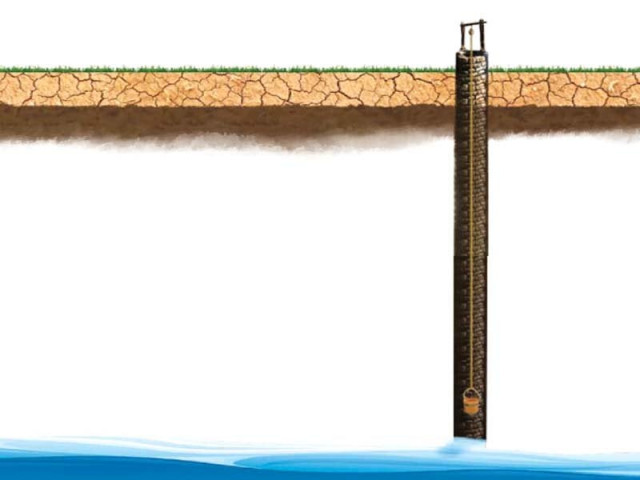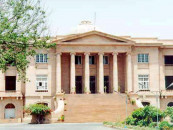Project to tackle Karachi’s water crisis likely to face further delays
Karachi needs about 1,100 MGDs of water on a daily basis but it currently faces a shortfall of 780 MGD

DESIGN: MOHSIN ALAM
To complete the project, the Sindh government needs Rs11 billion, however, only Rs500 million have been earmarked for it in the budget for the next fiscal year.
Meanwhile, out of the Rs600 million reserved for the project in the budget of the outgoing fiscal year, only Rs150 million had been released. It will come as a shock to Karachiites that the project was approved in 1985 as part of the city’s present water quota of 650 MGDs.
Per capita water availability may fall to 860 cubic metres
Demand and supply
The project could have been started 13 years ago through the construction of canals and conduits in the Keenjhar Lake to link them to the city - a move that could have addressed the shortage that the city is currently facing. However, the lukewarm attitude of the authorities, coupled with other priorities, led to unnecessary delays.
For the past one-and-a-half years, the Sindh government has neither approved Rs11 billion for the PC-1 of the project nor did it allocate the necessary funding to the original PC-1 that amounted to Rs5.9 billion.
To top it off, the negligent and laid-back attitude of the Karachi Water and Sewerage Board (KWSB) officials halted the development of the project for around 10 months in 2018. The development work commenced in 2017 with an 18-month deadline, but only about 15% of the work could be completed in the past two years.
According to KWSB officials, there is a considerable difference between the demand and supply of water in Karachi. At present, a total of 600 million gallons (MGD) of water is supplied to the city under the bulk water distribution system, while hindrances such as water theft, seepage in water lines, evaporation, and lack of capacity in water pumps only allow a supply of 420 MGDs to reach the city.
A project aimed at increasing the capacity of pumps at the Dhabeji Pumping Station was proposed and initiated but it is also facing undue delays. Based on its population, Karachi needs about 1,100 MGDs of water on a daily basis but it currently faces a shortfall of 780 MGD.
In view of the current shortfall, 65 MGD is quite an insignificant volume to meet the shortage but if the project had been completed on time, the ongoing water crisis would not have been as acute as it is now. Moreover, areas where water is not supplied for months could get some water on a rotational basis every 15 days.
For the past 13 years, the citizens of Karachi have been deprived of the city’s approved water quota. In 1985, during the government of former president Gen Zia-ul-Haq, 650 MGD of water was approved for Karachi from the Indus River, out of which only 585 MGD is being currently supplied.
Reasons for delay
At present, Karachi gets its water from the Keenjhar Lake through canals and conduits built under the K-III scheme. Under the scheme, the last water project was completed in 2006 with a capacity of 100 MGD. Per the plan, a canal with 65 MGD capacity had to be built after the completion of the project to account for Karachi’s approved water quota but the government of Sindh, together with the water board, focused its energies on getting additional water quota from the Indus River for the completion of the K-IV project.
Talking to The Express Tribune, a KWSB official - who spoke on the condition of anonymity - said that owing to the acute water shortage in the city, the board started employing efforts to start a water project in 2012, but it was approved by the provincial government only in 2014.
The initial study of the project was completed in 2016-17, while a budget of Rs1 billion was allocated for the project in 2017-18. However, out of the total, only Rs250 million were released.
The funds were utilised for carrying out a detailed study and creating the design of the project. The consultants completed the designing work within six months, after which the contract for the project was awarded to the National Logistics Cell (NLC) against the lowest tender bid. Soon thereafter, the project was kick-started. However, work related to Package-1 and Package-3 of the project is under way, while the tenders for Package 2 and 4 have not been awarded yet.
According to a KWSB official, in 2018, some high-ranking officials of the water board removed some engineers from the project. The project director and engineers were later appointed on the basis of neptoism with no field-work experience. The incompetent engineers termed the design unfeasible due to which the development work on the project remained suspended for 10 months.
Later, Local Government Minister Saeed Ghani took notice of the delay and transferred the engineers immediately. He also ensured the appointments of qualified staffers anew.
Based on Ghani’s instructions, the development work resumed in the beginning of 2019 but the provincial government has released only Rs150 million out of the approved total of Rs600 million for the project. Consequently, the development work on the project is going on at a snail’s pace with the total completion progress reported at 15 per cent.
The progress on development work has also been slowed down because the reviewed PC-1 of Rs11 billion is also being deferred. The operations at the pipe manufacturer used by the Karachi Development Authority (KDA) have been suspended due to which the KDA failed to procure the pre-stress pipes suggested by the design.
In addition, the water board has also been unable to procure other materials needed for the construction of the conduit. Prices of the construction materials have also gone up due to which development cost has increased from Rs5.9 billion to Rs11 billion. The water board prepared and forwarded a revised PC-1 to the planning and development department about a year-and-a-half ago. However, the approval for the new PC-1 is still pending due to which the water board has been unable to award tenders for PC-2 and PC-4.
K-IV project
The KWSB official further said that considerable changes have taken place in terms of the cost and design of the K-IV project, which has a capacity to process 260 MGD of water. The mega project is seeing delays due to increased cost as its original PC-1 was Rs25 billion which had to be equally shared by the federal and the provincial governments.
However, changes in the project’s design have led the revised PC-1’s cost to jump to Rs75 billion. To see to the matter, the Sindh government has tasked the National Engineering Services Pakistan (NESPAK) to ascertain the reasons for the changes in the design. After a drastic increase in the project costs, it is difficult to state whether the federal government will approve the new PC-1 or agree to increase its share.
WASA sets up emergency camps ahead of monsoon
Importance
Under current circumstances, the 65 MGD project has gained immense significance. The project is completely funded by the provincial government and it does not involve a lot of technical difficulties or hurdles. If the Sindh government takes an interest in the project, this low-cost project could easily be completed in the shortest possible time.
Spanning a distance of 58 kilometres, the 65 MGD water scheme will link the Keenjhar Lake to Pipri Pumping Station. The project has four development packages, out of which PC-1 and PC-3 are under construction, which will include a 14.5-kilometre open RCC canal and a five-kilometre conduit from the Keenjhar Gajol Canal to the Gharo Pumping Station. The Halejee Lake will also be augmented at the same time with the installation of a new gate. From Halejee Lake, a water line will be linked to a new RCC canal.
The Express Tribune tried to reach out to the KWSB’s project director several times to confirm the news, but he was neither in his office nor available over the phone.
A KWSB spokesperson, however, said that the revised PC-I of the 65-MGD plan has been sent to the Sindh government for approval.
He said that the development work on the remaining two projects will begin shortly after the approval of the revised PC-I by the Sindh government.
Published in The Express Tribune, June 29th, 2019.



















COMMENTS
Comments are moderated and generally will be posted if they are on-topic and not abusive.
For more information, please see our Comments FAQ